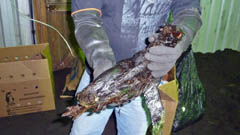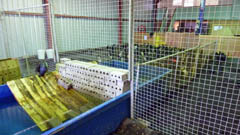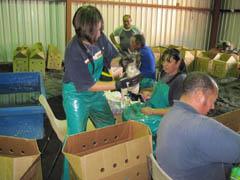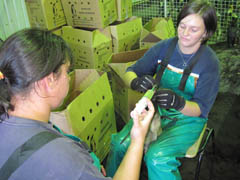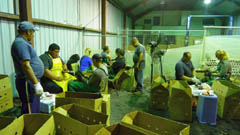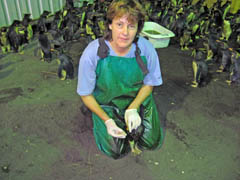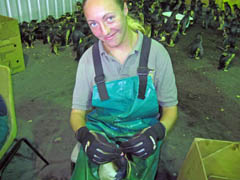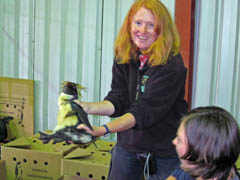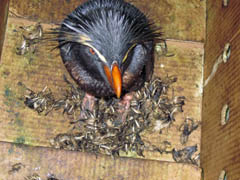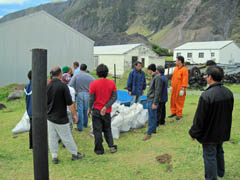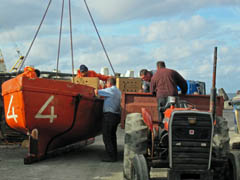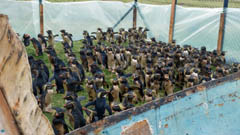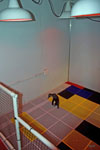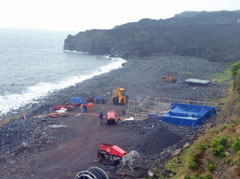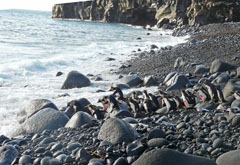News of the MS Oliva Emergency on Tristan Island
This page provides news and pictures of the back-up operation on the main Tristan da Cunha Island
Start from the beginning or go straight to the Latest News Bulletin for the latest news from Tristan da Cunha.
|
MS Oliva : Seabird rehabilitation on Tristan da Cunha main island
First Batch of oiled Rockhoppers come ashore on Tristan
RSPB's Project Officer Katrine Herian's distressing images are shown below and speak for themselves
|

|

|
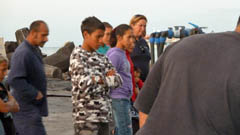
|
Above:
Barge comes in to Calshot Harbour with special boxes containing penguins
Below:
A badly oiled bird
These pictures were taken as 19 of the 473 penguins were brought ashore late on Wednesday 23rd March
|
Above:
Islanders speechless as they
witness
a scene they never thought possible
Left:
Oil caked penguins huddled
in their cardboard crate
Below:
Inside the PWD shed
where the rehabilitation work is carried out.
|
|
|
|
Penguin Clean-Up Operation
In one of the most remarkable wildlife rescue operations ever undertaken, hundreds of oiled Rockhopper Penguins are being carefully corralled on Nightingale and Inaccessible Islands, transferred by dinghy to MV Edinburgh, then brought to Tristan, unloaded into island barges, then ashore into a rehabilitation shed in the island's PWD Department.
In the first penguin transfer MV Edinburgh transferred 473 penguins to Tristan on Wednesday 23rd March. 19 were unloaded that evening and the remainder early on Thursday 24th March (so an earlier estimate of 500 penguins was then corrected).
The rockhoppers arrived from Nightingale Island in specially constructed cardboard containers brought on the tug by Estelle van der Merwe who is now coordinating this amazing penguin clean up and instructing a small army of Tristan volunteers in this important task.
Pictures below from Tina Glass below show this remarkable rehabilitation work
Tina Glass has recently moved from her teaching job at St Mary's School to join the Tourism Department with a specific brief to provide regular news and pictures for www.tristandc.com and the twice-yearly Tristan da Cunha Newsletter.
It is a coincidence that her arrival coincides with world-wide media interest
in the MS Oliva environmental emergency
|

|

|
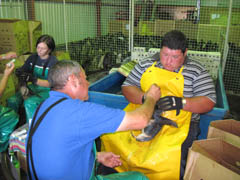
|
Emma Rogers and Sasha Green |
Richard Green and Jonathon Repetto |
Richard Green and Jonathon Repetto |
|
|
|
Sasha Green and Emma Rogers
Front right: Dereck Rogers
|
Sasha Green and Emma Rogers |
Emma Rogers and Sasha Green |
|
These pictures taken by Tina Glass
on Thursday 24th March
Picture right shows
Chief Islander Ian Lavarello
observing the operation
|
|
Richard Green and Jonathon Repetto |
|
Jeffrey Rogers and Dereck Rogers
Back: Ian Lavarello
|
|
Thursday 24th March Report from RSPB Project Officer Katrine Herian at 17.00 |
Stabilising 473 Rockhopper Penguins
Reporting at 17.00 on 24th March, Katrine reports that after the first transfer of 473 rockhoppers this morning the team (shown above)
has begun stabilising them with fluid, vitamins and charcoal to absorb
ingested oil. The first priority is to get food into them as the birds are very
hungry. Islanders are trying locally caught five fingers, yellowtail and
crayfish. In the last hour penguins have started taking small half inch squares of
five fingers. The Sandy Point Express barge went out today catching
fish specifically to feed the penguins which is being filleted ready to feed to the hungry rockhoppers.
Dangers of washing too early
Washing of birds hasn't started yet. Birds are being stabilised first.
Unfortunately heaters or infrared bulbs are not available to keep the birds
warm after washing. There is a high risk of pneumonia developing if they are
cold.
The Tristan swimming pool has been closed for swimming and is being
drained of chlorinated water to be partially refilled and used for
birds that are not so badly oiled.
Second delivery of penguins from Nightingale, Alex and Inaccessible
529 more oiled penguins are due to be brought to Tristan aboard MV Edinburgh at 19.00 today from Alex and Nightingale Islands. The Inaccessible Team have reported that they have 450 oiled penguins corralled from the two rookeries at
Blenden Hall and Warrens Cliff, awaiting transport to Tristan.
Molly fledgling rescue
Head of Tristan's Conservation Department
Trevor Glass is bringing a fledgling Molly (Atlantic Yellow-Nosed Albatross) fledgling back with him that was found
oiled after first flight. Reports indicate the young molly (you won't get a yellow nose for a while!) has been successfully washed and is being kept warm near the vessel's funnel.
Katrine has sent pictures which are being processed for publication later today with our next update.
|
|
Images from Katrine Herian taken on Friday 25th March |

|
Four scenes in the
Tristan rehabilitation shed
Below:
Construction of an outdoor pen
for fitter penguins as the shed can only
cater for about 1000 penguins.
|

|
Left to right:
Vanessa Lavarello, Sasha Green, Emma Swain, Kirsty Green, Brian Rogers
|
|
Sasha Green and Vanessa Lavarello |
|
|
|
Left to right:
Jonathon Repetto, Dereck Rogers, Richard Green
|
Oliva Crew constructing the outer pen |
Left to right:
Brian Rogers, Jonathon Repetto, Vanessa Lavarello, Marie Repetto, Alfred Rogers, Gerry Repetto, Dereck Rogers, Kirsty Green |
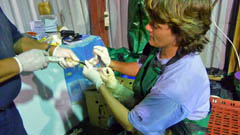
|
Tristan Agricultural Officer and Vet
Dereck Rogers and Conservation Adviser Estelle Van der Merwe
feeding the fledgling
Atlantic Yellow-Nosed Albatross
named ' Tristan'
that was named by the MV Edinburgh crew who brought it over.
|
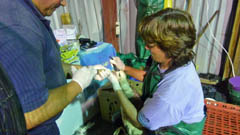
|
| Images below from Tina Glass taken on 25th March 2011 |
|
|
|
Estelle Van der Merwe |
Kirsty Green |
Katrine Herian |
|
|
|
The indoor penguin pool |
Oiled rockhopper moulting in its container |
MS Oliva crew helping
with the outdoor penguin pen |
|
Calshot Harbour scenes
as boxed penguins come ashore
from Nightingale for rehab
|
|
|
Friday 25th March Report from RSPB Project Officer Katrine Herian
1228 Rockhoppers undergoing rehabilitation on Tristan
Katrine reports that the penguin transfer is continuing apace. 755 penguins were brought ashore from Nightingale aboard MV Edinburgh today giving a total of 1228 penguins now being rehabilitated ashore on Tristan. The operation continues in the hastily organised, but professionally run facilities and mobilising many Islanders who are determined to save the lives of as many Rockhoppers as possible.
Transit from Alex or Middle Island
Alex Island contains the largest Rockhopper Penguin Rookery and it is understood that its rugged coastline is also the worst effected by oil pollution. Landing is very difficult and in some seasons counts cannot be arranged. On 26th March it is planned for the Tristan Conservation Department to go ashore on Alex Island to transfer as many oiled penguins as possible to MV Edinburgh for onward transit to Tristan for rehabilitation. It is crucial that the current good landing weather is maximised as these exercises are dangerous. Islanders work in small open boats making landings often on steep slippery bare rock landings, and will be impossible when the swell increases. Indeed Tristan's own Calshot Harbour is more often closed than open throughout the year. |
Saturday 26th March Report from RSPB Project Officer Katrine Herian at 19.00
Penguin Rehab Report
On Tristan the penguin rehab team fed approx 1400 penguins with at least 6-8 pieces of locally caught five fingers and yellowtail. The weaker penguins, approximately 200, were re hydrated and will be fed on Sunday 27th March. The Tristan based conservation team now have 1130 lesser oiled penguins in the outside pen where they have access to a pool and some shelter. They had to be moved out to prepare for receiving the next batch of oiled penguins. The converted PWD shed can only hold approx 1000 penguins and is the only facility available.
Swimming Pool in action
On Sunday 27 th March it is planned to move the cleanest penguins (less than 20% oiled) from the outside pen to the local swimming pool area where they will have access to the water. Chlorinated water has now been removed and the swimming pool filled with fresh water.
Sick Bay News of penguins, albatross and prion receiving intensive care
There are 22 weaker penguins in the 'sick bay' area of the rehab shed. One of the birds in the sick bay is a fledgling Molly or Atlantic Yellow-nosed Albatross, named 'Tristan' by the Edinburgh crew which brought the albatross from Nightingale to the main island. Tristan has been taking food today and is doing well. Also still surviving is a Broad-billed Prion (locally known as a ‘Night-Bird’) that was brought in from Nightingale on Wednesday evening covered in oil.
Oliva Crew's Sunday Project
On Sunday 27 th the crew from the MV Oliva will be helping to clear out two unused containers to use as a dedicated sick bay area to free up space in the main rehabilitation shed.
|
Images from Katrine Herian taken on Saturday 26th March
of the newly constructed outdoor penguin rehabilitation area
in action |
|
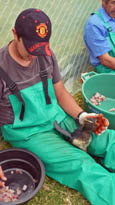
|
|
|
Lesser oiled penguins are being looked after in this outside area with access to a pool |
Left: Scenes of penguins being fed in a corner of the outside pen. |
|
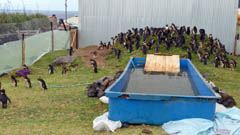
|
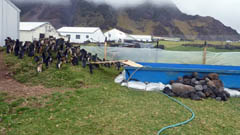
|
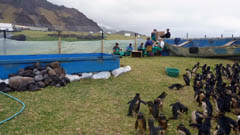
|
|
Sunday 27th March Report from RSPB Project Officer Katrine Herrian at 20.00
Tug visits Tristan for Planning Meeting
The tug Smit Amandla visited Tristan today. Salvage Master Ralph Laing and Spill Auditor Nick Sloane came ashore to have a meeting with Administrator Sean Burns and Environmental Advisor Estelle van der Merwe and to see the rehabilitation operation for themselves. They visited the rehab shed and pen and the swimming pool where the first penguins were released today.
Fishing for penguins despite wind and rain
Sunday is a wet and windy day on Tristan. Nevertheless the The 'Sandy Point Express' barge was out again today catching fish for the penguins. The tug’s crew sent ashore 20 cases of the local five fingers that they had caught for the penguins.
Rehab operation Update
On first arrival on Tristan oiled penguins are admitted into the rehab shed, the floor of which has been covered with volcanic sand which is absorbing some of the oil. The rehab team, headed up by island vet Dereck Rogers, fed more than 750 penguins today. Administrator Sean Burns’ wife Marina has joined the rehab support team and is working closely with Conservation Clerk Kirsty Green to organise personnel for the penguin rehab operation. This is a complex task given that most people on Tristan have several different jobs as well tending their livestock and crops.
Swimming Pool in action today
The first 80 of the lightly oiled (less than 20%) penguins were released in the island swimming pool today to allow them to swim and preen. The pool had been prepared with fresh water and an access ramp by Stanley Green and his team. The penguins were reported to have taken to the water immediately and were seen diving, splashing and were later preening.
Nearly 1500 Rockhoppers now in Tristan Rehab
At 5pm 253 oiled penguins arrived on island aboard two of the Edinburgh's power boats, to bring the total ashore in rehabilitation on Tristan to 1481. Conservation Officer Trevor Glass returned with the penguins and will now be based on Tristan as the rehabilitation centre manager.
Expanded team stabilises new arrivals
Ten more helpers were joining the core team this evening for training in handling and 'tubing' penguins. When penguins first arrive on Tristan they are dehydrated so are given electrolyte solution with a tube and syringe. Kirsty and Marina are also organising a daily supply of fresh fish to feed the penguins. The team effectively admitted and stabilised the group of penguins.
|
Photos from Katrine Herian taken on Sunday 27th March |

|
Left: Factory Power Boats
coming ashore from the tug
Smit Amandla
Right ~ Left to Right:
Salvage Master Ralph Laing, Spill Auditor Nick Sloane, Environmental Advisor Estelle Van der Merwe, Administrator Sean Burns and Dereck Rogers
|

|
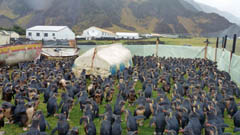
|

|
Far Left:
The outdoor penguin enclosure
Left:
Inside the rehab shed |
|
| Monday 28th March Report from RSPB Project Officer Katrine Herrian sent at 11.30 on 29th March
Weather prevents inter-island transport
Monday was cold, wet and windy day on Tristan da Cunha, with hailstorms during the day. Bad weather prevented any penguins coming off Nightingale or trying to get to Inaccessible as planned.
Tristan Penguin Rehab Update: 300kgs of fish need to be caught daily; Some penguin deaths in rehabilitation
Conservation Officer Trevor Glass is back on island and has taken over as Centre Manager. The rehab team have fed at least 1200 penguins on Monday 28th. Each penguin is currently getting 6-8 cubes of fresh fish, but this will need to be
increased as the penguins get stronger. We will need up to 200g of fish (raw meat weight) a day for each penguin. With 1614 penguins currently at the rehab centre, this means there is a need to catch over 300kg a day just to keep the current number of penguins fed. Fresh fish is preferable to frozen fish because the vitamins leach out when frozen. 57 penguins in total have died at the rehab centre since penguins were first admitted on Wednesday 23rd March.
The Sandy Point Express has been out again today with its crew trying to catch fish for the penguins, but the strong winds and heavy swell meant the catch was limited as they struggle to catch enough fish to keep the penguins fed.
|
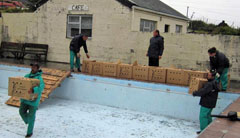
|

|

|
|
|

|
March 28th Estelle Van der Merwe
captures these images
of the team of Islanders
led by Dereck Rogers (centre)
carefully transporting and releasing
the first batch of fitter penguins
in the island's swimming pool |

|
|
| Tuesday 29th March Report from RSPB Project Officer Katrine Herian at 20.00
Bad weather hampers clean-up transport
Tuesday was another bitingly cold day on Tristan with strong winds and 5 metre swells. Bad weather prevented landing at either Nightingale or Inaccessible. MV Edinburgh took 5.5 hours to make the 25 mile journey between Nightingale and Tristan, a trip which normally takes around 2.5 hours. The tug Singapore left Cape Town today with the SANCOB team and equipment on board, delayed by fog the previous evening.
First oil pollution and oiled penguin in Tristan waters -
At 09.30 MV Edinburgh reported two oil slicks 3-4 miles off the south of Tristan. At 12.45 the first oil covered penguin was reported to have been found on the main island of Tristan. Fisherman Desmond Green found the penguin on the beach near Red Sands to the south-west of the Settlement Plain. Environmental Advisor Estelle van der Merwe confirmed that the penguin had been very recently oiled and that oil covered feather samples have been taken.
Conservation Officer Trevor Glass has arranged for a team of three to walk out from the Settlement early on Wednesday 30 th March to check the beaches down to the Caves and Stony Beach in the south of the island.
Penguin Rehabilitation News
In the rehab shed the team are doing really well and fed every single penguin, 1593 penguins in total. More of the cleaner penguins were moved out to the swimming pool, making 282 now in the pool. There are approx 500 penguins left in the shed which gives us room for up to 600 possible new arrivals, as the rest were all strong enough to go outside. It also provides an opportunity to put down a fresh layer of volcanic sand. Nightingale is still holding approximately 600 penguins which it is hoped can be collected soon.
Penguin casualties rising
An intensive care unit or ‘sick bay’ was set up today in a portable container with an adjacent holding area. There are 98 penguins in the ICU and these thin and weak penguins are being given electrolytes and tube fed with Hills a/d, a high nutrition solution. Penguins here are receiving special attention mainly because of being underweight. There were 22 penguins that died in the rehab centre on Monday 28th plus the Broad-billed prion from Alex Island which was heavily oiled, and 21 dead penguins on Tuesday 29th.
Editor's note: It is understood the total number of dead penguins during Tristan rehab is now 96.
Team work to keep penguins fed with fish
The Sandy Point Express was out again today with a team of fishermen catching fish for the penguins. Pensioner Joyce Hagan and Diana Green were cutting up fish all day into little squares for feeding the penguins.
|
Wednesday 30th March Report from Marina Burns at 17.30
Good weather helps rehabilitation work
The weather has been much kinder today, which has helped greatly with the rehabilitation work.
It is a delight to report that all 1695 penguins were fed well today with some now hand feeding from team members.
There are now three fully operational teams of workers with a fourth group of trainees ready to join
the teams on Friday 31 st March. The three teams worked hard to ensure that all penguins were fed by 1430 and interior pens cleaned.
With the exception of 85 particularly oiled penguins, all other penguins have now been moved either to the swimming pool or the first exterior pen. The birds in the swimming pool are preening themselves and looking cleaner and more waterproof every day.
A second exterior pen has now been erected with water dishes, but awaiting a pool. This will be for the housing of strong but thin birds, who will be fed twice a day to strengthen them before release. The pen will contain upturned boats which will provide necessary shelter for the penguins.
The separate sick bay is now up and running with 90 thin and weak birds being cared for intensively. We can report that
only 8 deaths were registered today.
Some oil ashore and more oiled penguins on Tristan
Oil has been reported on the west side of the island from Anchorstock Point to Hacklehill Road. A team was mobilized
on foot this morning to walk to the Caves and Stony Beach but we await a report. Two further oiled penguins were found on Runaway Beach this morning.
Tugs to cross in mid-ocean
The tug Smit Amandla left for Cape Town this morning at 1000 leaving behind the Spill Auditor Nick Sloane and a team
of six divers. The delayed tug Singapore left Cape Town eventually at 1800 on Tuesday 29th and will probably arrive late on Sunday 3 rd April. Aboard the Singapore are the SANCCOB staff together with Mark Whittington from ITOPF. The tug is carrying essential equipment and materials for the washing and rehabilitation of the penguins.
|

|

|

|
Estelle Van der Merwe's pictures taken on 30th March show left and right penguins now accepting food voluntarily by hand |
Centre: What's this all about: A penguin that came in oiled and undernourished six days ago now in good health and almost ready to return to sea |
|
Thursday 31st March Report from RSPB Project Officer Katrine Herian at 18.00
News of Tristan Seabird Rehab – Penguins taking to hand feeding
There are now approximately 2400 oiled penguins in the rehabilitation centre divided between the shed, ICU, outside pens and the swimming pool. More of the cleaner penguins (less than 20% oiled) were transferred to the pool today, making 544 penguins there in total. Justin Green, one of those feeding the penguins at the pool, reported that there are now thirty penguins taking fish strips by hand. Each penguin is given up to 15 strips and some of the penguins are then pecking at the feeders' boots for more. Penguins in the 'thin' penguin pen are being fed twice a day. This means that we currently need over 450kg of fish (raw meat) each day to feed all the penguins. The rehab team on Tristan are on standby to receive 539 penguins to be transported there this evening, bringing the total on the main island close to 3000.
|

|

|

|

|
Photos from Tina Glass
show scenes around the swimming pool
and in the rehab shed
on 29th and 30th March
Above Right:
Justin Green
Right Middle:
Francesca Green, Glynis Swain, Donna Rogers, Janet Lavarello and Joan Repetto
Right:
Janet Lavarello and Joan Repetto |
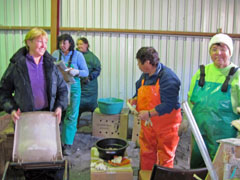
|
|
|
|
Sunday 3rd April Report from Tristan Administrator Sean Burns and RSPB's Katrine Herrian
Good News at last as first Rockhopper Penguins released to the ocean
Administrator Sean Burns reported the good news that a first batch of 24 fit and well fed Northern Rockhopper Penguins were released into the ocean this evening.
Conservation Officer Trevor Glass commented that the penguins were in perfect order, all their plumage had been checked and found dry. It was an emotional moment and Trevor said he was more than happy to see the first batch go back to sea.
The penguins selected for release were selected from the strongest ones with no visible oil on their outer plumage. These penguins have been swimming in the release pool for several days. Of those tested to see if they were ready for release, only 24 had perfectly waterproof plumage.
|
Photographs from Sean Burns (and two below from James Glass) show the release of the first batch of Northern Rockhopper Penguins from Salt Pot Beach west of Calshot Harbour on 3rd April |

|
Left: Penguins being driven to the harbourside
Right:
The group ready to release the first penguins
Left to right ~ Trevor Glass, Estelle Van der Merwe, Jeremy Green, Philip Rogers, Jason Green, Katrine Herian and Lourens Malan
|
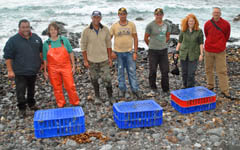
|
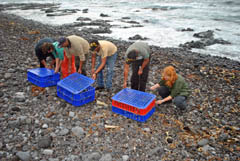
|

|

|
Ready |
Steady |
Go |

|
These two pictures from James Glass
show the penguins taking to the ocean
with MV Edinburgh
(who brought the penguins
from Nightingale) offshore.
|

|
|
Monday 4th April Report from RSPB Project Officer Katrine Herian
Systematic Rehabilitation Process
After arrival on Tristan penguins are stabilised and kept indoors in the rehab shed, after which the strongest ones are moved to the outside pen. From here the cleanest and strongest ones are moved to the release pool where they are fed every day with fish, and encouraged to swim in the pool and to preen themselves. When it is deemed that the penguins have waterproof plumage they will be released to the sea, following the first batch on Sunday 3rd April.
Swimming Pool Hygiene
The swimming pool now used by the fitter penguins pool is filled with fresh, unchlorinated water on a daily basis. Environmental Advisor Estelle van der Merwe reported that the not so heavily oiled penguins admitted to the centre, were doing an exceptional job of swimming and preening themselves clean.
Penguin Rehabilitation Success
90% of penguins surviving in rehabilitation
So far, 3662 oiled penguins have been admitted to the Tristan rehabilitation centre. 373 have died since the first batch of penguins were admitted on 23rd March. About 25% of the penguins at the centre are currently in the release pool. There are still many oiled penguins which require urgent washing and we are eagerly awaiting the arrival of the SANCCOB team and the specialised equipment and materials needed for washing. These arrived aboard the tug Singapore today, but due to rough seas nothing was unloaded at Nightingale or Tristan, but it is hoped that may be possible on Tuesday 5th as the clean-up operation enters a new phase.
|
Wednesday 6th April Report from RSPB Project Officer Katrine Herian
Tug Singapore unloads
On the afternoon of Tuesday 5 th April, after seven days at sea on board the support tug Svitzer Singapore, the SANCCOB team were able to get ashore at Tristan while offloading began of the specialist equipment and materials needed for washing the penguins. Vital vitamins and medicines also came ashore and these were already being put to use in the rehab centre’s intensive care unit later that evening. Venessa Strauss, CEO at SANCCOB (The Southern African Foundation for the Conservation of Coastal Birds) reported the team were relieved to get ashore, as bad weather had kept them on board the tug Singapore one extra day which had been very frustrating. Offloading SANCCOB's equipment from the “Svitzer Singapore” continued throughout Wednesday, and weather permitting should be completed on Thursday 7 th April.
SANCCOB Team impressed with Tristan rehabilitation effort
This morning the five members of the SANCCOB team including Veterinarian Tertius Gous, met many of the islanders involved in the rehab operation as they started their daily shift tubing and feeding the penguins. The SANCCOB team were impressed with the set up at the rehab centre and praised the islanders’ efforts under difficult conditions and with very limited resources. It is now two weeks since the first oiled penguins arrived at the rehab centre, and three weeks since the OLIVA grounded on Nightingale Island.
Cleaning operation planned
Today work began on installing specialist equipment at the wash-bay facility which will be housed in two government containers close to the rehab shed. Here hot water geysers will be installed for the penguin-washing operation (to remove the heavy bunker oil), as well as infrared lights in a drying room. Outside, large tanks will collect and separate the waste-oil/ solids and grey water from the washing process. SANCCOB logistics manager Mariëtte Hopley reported the washing facility would be up and running on Friday, when training would begin for islanders in the washing of penguins.
The rehab shed was cleaned out and disinfected before turning it into a dedicated unit for sick and weaker penguins. Working closely with the island rehab manager Dereck Rogers, the SANCCOB team separated penguins by habitus, with the very weakest penguins being moved into the rehab shed.
Pilchards imported to supplement local fish food for penguins
By midday the first boxes of frozen pilchards had come ashore and were being defrosted and fed to the stronger penguins which are being prepared for “washing” over the weekend. Each penguin was fed one pilchard for the first day, as they need to get used to the change in diet from the local yellowtail and five fingers fish fed to them thus far.
Outer islands oil pollution assessment
Dr. Mark Whittington (of ITOPF) , and Mr. Jean-Luc Dardidon (of Le Floch), visited Middle & Nightingale Islands to assess the residual oil remaining in the bays and on the rocks after the OLIVA grounded on the 16 th March. A plan shall shortly be formalised to deal with the remaining oil, and to prevent further impact on the penguin and bird colonies.
|

|
Photographs from Katrine Herian
taken 5th and 6th April
The tug Svitzer Singapore
being unloaded
|
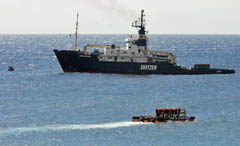
|
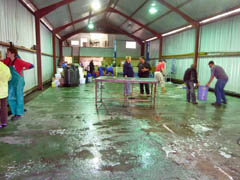
|
Left: Cleaning the rehab shed
Right: Newly arrived water tanks for the forthcoming washing operation |
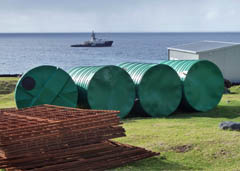
|
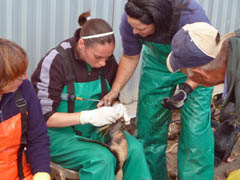
|
Marlei Martins giving training
to Glenda Swain
in using a tube
to re-hydrate and feed
a weaker penguin
|
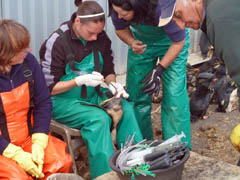
|
|
Saturday 9th April Report from RSPB Project Officer Katrine Herian
First five rockhoppers washed
By the evening of Friday 8 th April the first five rockhopper penguins to be washed at the newly erected wash-bay facility were drying off under infrared lights. This was a rewarding moment for rehab manager Dereck Rogers who has been very closely involved with the care of the penguins from the moment the first oiled penguins were brought back to Tristan two and a half weeks ago. He was elated at being able to hold a cleanly washed penguin.
Team effort to erect wash-bay facility
The past few days have seen the whole island working together to ensure SANCCOB have everything they need to erect the wash-bay facility, post-wash pens and pools. The island plumbers, electricians, carpenters have all been on standby to assist with the operation, as well as plant operators for moving equipment and materials. SANCCOB have installed three large hot water geysers in the wash-bay to heat the water for washing, as well as hundreds of metres of piping and cable to link in to the island’s water and electrical supplies.
Oiled penguins tackled by spray and then a warm bath
On the morning of Saturday 9 th April the washing of oiled penguins got well under way as the first ‘washing-team’ comprised of islanders received training from SANCCOBs Venessa Strauss. The washing-team work in pairs and island Administrator Sean Burns watched with interest as the first pair were taken through the thirty minute process. This entails spraying a fine mist of de-greaser (breaks down the oil/s as a pre-wash application), over the feathers of the penguin while carefully protecting the bird’s eyes. The penguins are then washed in a warm bath of biodegradable soap and anti-septic solution, gently working the feathers from the base of the penguin up.
Further treatment: second wash; rinse; shower and hydration
After a second wash with the soap and a gentle clean around the eyes with a toothbrush, penguins are taken to a rinsing bay. Here SANCCOBs Jennie Bancroft showed islanders how to rinse the penguins’ feathers making sure that none of the rinsing water is ingested by the penguins. A high-pressure shower head is used in order to fluff up the feathers. After a hydration treatment of fluid with electrolytes and glucose, the washed penguins are then tagged and put in a recovery pen under infrared lamps for warmth while they dry off.
Transfer to pens with access to a swimming pool
They are later moved to small clean pens which will each have access to a swimming pool where there are encouraged to swim. Sixty-four penguins were washed today but SANCCOBs vet Tertius Gous, said they were aiming to wash up to a hundred a day once the washing-team are in full swing.
Feeding operation continues
Meanwhile at the holding pens for oiled penguins the feeding teams were hard at work trying to satisfy the hunger of the many penguins waiting to be washed. Pilchards are being fed to the penguins at the village swimming pool and in the outside pens to build up their strength before undergoing the washing process. Some of the more lightly oiled penguins at the swimming pool are being ‘swum’ every day after which their waterproofing is tested. As soon as these penguins satisfy the release criteria of effective waterproofing and sufficient weight, further penguins will be released.
Latest Penguin Count
To date 3662 penguins have been admitted to the centre, 1577 have died, 69 have been washed and a further 24 released back to sea.
|
Final stage of penguin rehabilitation underway as cleaning begins
Photographs from Katrine Herian and Tertius Gous taken on 8th and 9th April 2011 |
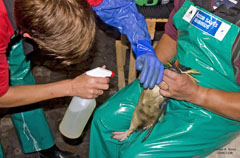
|
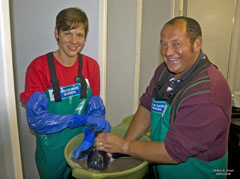
|
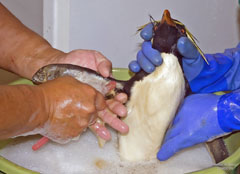
|
Spraying de-greaser onto feathers |
Venessa Straus and Rehab Manager Dereck Rogers washing the first penguin |
Washing a penguin flipper with a toothbrush |
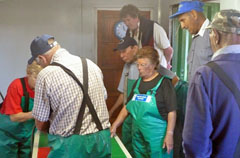
|
Administrator Sean Burns (centre back) watches with others the rinsing process
Right: Penguins warming under intra-red lights after washing
Far right:
the first penguin in the drying room |
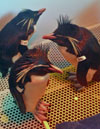
|
|

|
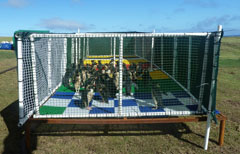
|
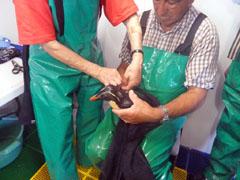
|
Hot water geysers |
Holding pen for penguins ready for washing |
Tagging a washed penguin |
|
Monday 11th April Report from RSPB Project Officer Katrine Herian
Arrival of Ivan Papanin Imminent
Tristan awaits the arrival of the Ivan Papanin on Tuesday 12 th April with clean-up materials, equipment and further personnel. Mark Whittington of ITOPF has produced a clean-up plan and the helicopter being brought by the ship will be crucial in accessing sections of coastline on Inaccessible, Nightingale, Middle and Stoltenhoff Islands not yet properly assessed for pollution.
Fine tuning penguin rehabilitation
It is difficult to work out how many penguins are to be washed, as lightly oiled rockhoppers can be swum clean at the swimming pool. The team at the pool hope to do this each day and at the same time
test the waterproofing of the penguins. Once criterion for penguins that are washed has been established, no penguin less than 1.5kg in weight is put through the washing process.
Last oiled penguins from Nightingale Island enter Tristan rehab
Late in the afternoon of Sunday 10th April the last oiled penguins from Nightingale arrived at Tristan on the Singapore. 56 oiled penguins were admitted and SANCCOBs vet Tertius Gous reported that all but 13 seemed to be
strong. This brings the total entering rehabilitation on Tristan to 3718 Rockhoppers. The Nightingale team reported that no further oiled birds had been seen on Alex Island, only 1 clean penguin and 2 dead.
|
Pictures from Katrine Herian show the last oiled penguins arriving from Nightingale Island on 10th April |

|
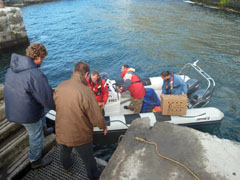
|

|
The RIB Arctic Tern bringing boxes containing oiled penguins
from the tug Singapore |
The final load of oiled penguins
arrive on the Arctic Tern
into Calshot Harbour
|
Neil Swain and Trevor Glass
inspect the last oiled penguins
in a trailer at Calshot Harbour |

|
Tuesday 12th April : A remarkable five ships at Tristan
Katrine Herian took this picture of Left to right:
Tug Singapore, MV Baltic Trader, MV Edinburgh, The Ivan Papanin which carries a helicopter to help with the MS Oliva clear-up and the new cruise ship MS Plancius all at the Tristan anchorage at the same time.
Keen Tristan historians are asked to let Richard Grundy know when the last time
five or more ships were at the island anchorage at the same time.
His 87 year old pal Ernie Repetto tells him never in his lifetime!
|
|
Wednesday 13th April Report from RSPB Project Officer Katrine Herian
‘Ivan Papanin’ arrives at Tristan
The Russian research/Antarctic supply vessel ‘Ivan Papanin’ arrived on 12th April. It is the fourth vessel chartered by the owners of the MS Oliva and their insurers since the incident, following after the ‘Edinburgh’, ‘Smit Amandla’ and the ‘Svitzer Singapore’. The ‘Ivan Papanin’ carried the balance of the SANCCOB supplies and oil abatement equipment that was not able to be collected prior to the departure of the third vessel, the ‘Svitzer Singapore’ on 29th March. She also carries a Bell-212 helicopter, which will greatly improve the deployment of the oil abatement teams and equipment into the oiled gulleys and bays on Alex (or Middle) Island, the focus of the clean-up efforts.
Team of over 100 now working on the clean-up
There is presently a 28-person-strong team of international responders on the island, including SANCCOB, Veterinarians, ITOPF staff, and Oil Pollution & Salvage response experts, working alongside an 80-strong island volunteer force. With the onset of the southern winter, the adverse weather has brought with it gale force winds and heavy seas. While hampering the clean-up response, these have broken up the majority of the released oil, although there are still clear signs of pollution around Nightingale. Fortunately the penguins have completed their moulting period, and the vast majority of the penguins have left the rookeries and gone to sea following feeding grounds during the pelagic period of their yearly cycle. They are not back at Tristan until they return in August for the start of the next breeding season.
|
Molly Tristan washed
Those of you who have been following the MS Oliva clean up saga regularly on www.tristandc.com will have been amazed at the scenes on Tristan da Cunha of the extra-ordinary penguin rehabilitation programme. But you will have wondered what happened to Tristan the fledgling Atlantic Yellow-nosed Albatross found after first flight covered in oil, kept warm by the funnel of MV Edinburgh on the trip over, and then outnumbered by rockhoppers in the Tristan rehab shed.
Photographs below from Tetrius Gous show 'Tristan' being carefully washed and finally back to his / her usual colours.
We do hope to report before long that Molly Tristan will be able to continue flight and feed for him/herself in the South Atlantic Ocean.
|
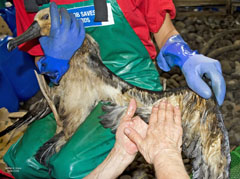
|

|
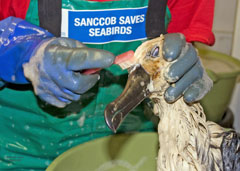
|
Canola oil being applied to Tristan's wings |
Jennie Bancroft and Venessa Straus washing Tristan |
Washing Tristan's head |

|
Images and information
from RSPB Project Officer
Katrine Herian
on 15th April
Tristan was washed on 11th
April and has now been moved to a larger pen in the ICU unit where he/she has more room for
exercising his/her wings.
For more about Mollies see our:
Albatross Page
|

|
Tristan getting a rinsing |
The new Molly Tristan |
|
Sunday 17 th April Report from RSPB Project Officer Katrine Herian
East Beach release pool completed
A ‘release pool’ was finally completed on Sunday 17th April after three days’ intensive work. All washed penguins will be brought here to be swum and fed in the days up until they are released back to sea. The release pool is made up of two adjoining 6 x 6 metre pools that have been constructed above the storm-water line on the east beach below the settlement. The first pool is fed with seawater pumped up from the shore along a 75mm diameter hose. This overflows into a second pool from which the water is very slowly draining, maintaining a constant circulation of freshened water. This will ensure that any surface residues, for example fish oil, are regularly removed.
It has been a logistical challenge getting this facility up and running. SANCCOBs Logistical Manager Mariëtte Hopley reported it was originally planned to be located close to the rehab shed but due to the lack of level ground, had to be relocated. The heavy steel frames for the perimeter pen fences and pool sides were pre-welded in South Africa. On site these have been welded to scaffolding poles for extra rigidity, and metal building-floor mesh has been used to support netting along the sides. One huge piece of heavy gauge PVC plastic was laid over the steel frame to line both pools and with access ramps in place and shade netting around the perimeter of each pen for a wind break, the release pool was ready to receive penguins.
First rockhoppers using pool
By midday on Sunday 17th, the first 120 of the 400 plus rockhoppers now at the release pool were brought down from the rehab centre by tractor and trailer. It was a humid, hot day on Tristan and the penguins took to the water with visible relief at being able to cool down and swim in the spacious pools. The strongest penguins were darting and diving underwater and washed vigorously for a good ten minutes before clambering out on the pool ramps. Rehab manager Dereck Rogers will be taking overall charge of the rehab operation after the ‘hand-over’ from SANCCOB, and will be overseeing the daily feeding, swimming and testing of the penguins’ plumage for waterproofing prior to their release.
Each of the two pools has its own pen area with pebble floor where the clean washed penguins can dry off and preen in between swimming and feeding. SANCCOB’s Mariëtte Hopley reported the floor had been constructed as a ‘natural French drain’, so graded sizes of large pebbles, smaller pebbles and gravel were used to a depth of 30cm to allow the guano produced to be washed and filtered through this system when the floor is hosed down each morning.
Planned transfer from SANCCOB to local staff
With the departure of the SANCCOB team scheduled for 23rd April on the ‘Ivan Papanin’ and more than 1300 penguins still remaining at the rehab centre, SANCCOB have submitted a Plan of Action to the Tristan Administration for the management of the rehab operation until it is completed. To date 3718 penguins have been admitted to the rehab centre, 2378 have died at the centre and 24 penguins have been released.
|
Katrine Herian's images of the East Beach release pool project |
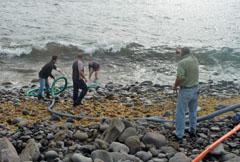
|
Left: preparing to pump sea water
Right: Penguins being let into the release pool by Joseph Green
Below: Penguins swimming in the release pool and resting after swimming |
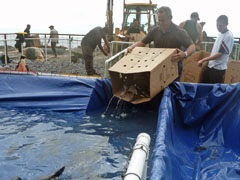
|

|

|

|
|
Views of the east Beach
release pool complex:
Left:
during final construction on 17th April
Right:
Fully functional on 18th April
|
|
|
Edited Report from Administrator Sean Burns on 27 and 29 April
Ivan Papanin's Departure
The ship left on 23rd April as planned with the team including ITOPF and SANCCOB personnel. Sean thanked them for all of their help and support as he had others who had left earlier on board the Edinburgh, the Amandla and the Singapore. They had all assisted the island and contributed in one way or another during the crisis that hit the island on 16 March. Sean pointed out that there was still a lot of work to do to clean and release the birds and to clean up the oil but was grateful for the resources (material and financial) they had left behind and pledged to help Tristan the disaster through. He wished them a good and safe voyage back to Cape Town.
Penguin Update
Public Swimming Pool
The heavily oiled birds had been kept here, but on 25th April all 177 birds were moved to the main pen, where all but 30 or so have now had a mild wash. Previously only birds of 1.5 kg or more were washed but it has been found that if they receive a 'mild' wash, they respond well. It was no longer an option to leave them at the pool as they were becoming heavily soiled and further oiled (from the pilchards) and were no longer entering the water and cleaning themselves.
Main Pen
There are 29 penguins in this area but 20 or so are birds that have come from the release pool for a further rinse. Again, a good response in terms of weight and feather gain and these are the birds (the 20 who have had a secondary rinse) it is hoped will be release this weekend. Whilst everybody is keen to release birds, this cannot be rushed as they have to be in good condition for their long voyage.
ICU
Currently around 116 penguins here, including the birds who came from the public pool and had a mild wash on Monday. They are then given extra treatment in the ICU to hopefully see them through to the next phase.
Release Pool
Currently 301 birds, most of which are doing well but with the success of the experiment to re rinse the 20 birds, we now think they all need another rinse in preparation for release.
Summary
So there are currently around 446 birds. Unfortunately there are still penguin deaths, mainly in the release pool where they struggle with the cold and the swimming.
The team are no longer force swimming the birds as it is felt it was just too stressful for them, and may have led to casualties. The strategy now is to focus additional care and re-rinsing on those remaining, build them up, monitor their feathers and then release...when they are ready.
|
Report from Administrator Sean Burns on 8th / 9th May
Final Effort to rehabilitate remaining Rockhopper Penguins
There are currently 420 penguins remaining in rehabilitation on Tristan. They are putting on weight really well but they are still not waterproof and therefore not ready for release. Trevor Glass has sent some photos to Tertius Gous for his advice on the downs around the neck, which are growing very slowly.
A decision has been made to change the penguins' diet back to cape mackerel as it is less greasy and it is thought this may help. Water is changed in the pools every day which is also making a difference.
Deaths are now right down to a few per day and there are now very few birds in ICU with the majority of penguins down at the release pool on East Beach. The team working on the project will move down to about 25 from 10 th May and will mainly consist of pensioners plus some of the key local managers.
So hopefully, when feathers and waterproofing are right more penguins will be released soon.
|
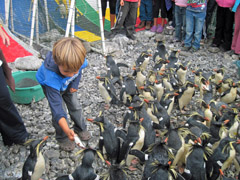
|
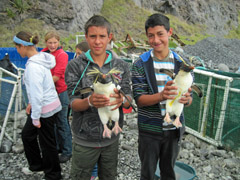
|
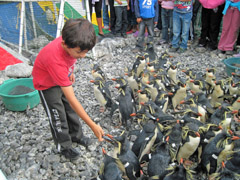
|
Jamie Glass |
Rhiaan Repetto and Dean Repetto |
Nathan Swain |
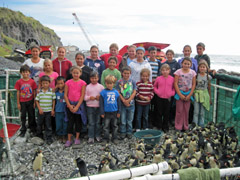
|
Photos from Tina Glass
of St Mary's School pupils
visiting the East Beach
Release Pool complex
on
25th April
Left: School children
gathered in one of the pens
Right:
Kelly Swain |

|
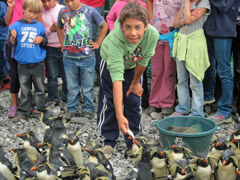
|
Left: Leo Glass
Right: Randall Repetto |

|
|
Report from Marina Burns on 23rd May
Penguin Rehabilitation Project Update
The penguin rehabilitation project team continue to work relentlessly in all weathers, in an effort to secure the successful release of clean, healthy, waterproof birds. The team is now working in three specific areas, namely the west pen, the beach (release pen) and the ICU shed. As of today there are just 30 birds remaining in the west pen with a further 60 having been moved down to the beach release pen this morning. The remaining 30 birds still require more weight gain before being transferred. These birds were weighed again this morning with weights recorded ranging from 1.2kg – 1.4kg. Once these penguins are nearing the 1.5kg mark they will be transferred down to the release pen, after which the west pen will be dismantled and the surrounding areas cleared and cleaned. East Beach Release Pool
There are now 337 birds being housed in the beach release pen. This pen has been sub-divided into three separate sections: the west section for birds just below 1.5kg; the central area for those weighing between 1.5kg – 1.7kg; and the east section for birds above 1.7kg. Birds that have been transferred to the east section are not only of the appropriate weight for release, but have also gone through vigorous checks by the team for waterproofing.
Trial Release on 21st May
With this in mind, it was decided to carry out a trial release of 25 of the fittest birds on Saturday 21st May. The birds were released from the pen where they headed straight down to the sea into the open water. They set off in groups, with a few stragglers at the back. Of the 25 that were released 1 came straight back ashore. The bird was examined and was confirmed to be waterproof. A further 7 returned after approximately one hour, 2 came ashore at Hottentot Beach 24 hours later and 1 returned to the release pen unaided yesterday afternoon (a good 36 hours after release). All these birds are in good health and have shown no signs of distress or weakness. There are a further 110 birds in the east section ready for release, and following on from the relative success of Saturday’s trial (there were no known fatalities), the rehabilitation team are now working on a plan to release this entire group of birds. In the meantime, all birds continue to feed by hand and swim in the pools daily.
ICU Latest
The ICU shed currently contains 11 weak and underweight birds. In order to clean up the shed, the ICU will be moved to the wash bay which has a snug warm pen for the weak penguins.
|

|

|
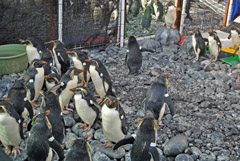
|
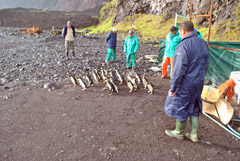
|
Photos from Marina Burns
showing scenes on 21st May
when
a further release
of fit penguins was carried out
|
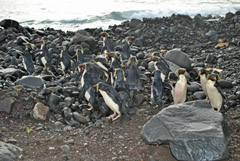
|
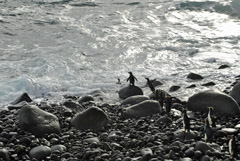
|

|

|
|
Report from Tina Glass on 31st May
Latest release of 120 penguins
It is pleasing to report that on Monday 30th May at 2pm 120 penguins were
released from the pen on East Beach. It only took the first one to take the plunge and the others followed
in swift pursuit. Unfortunately one rockhopper
decided he was not ready to go so was returned to the pen. The release was watched
with great excitement by the school children and many others.
Photos below from Tina show the crowd gathered to watch the penguin release and views of the rockhoppers taking to the ocean.
|
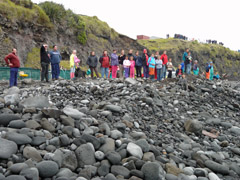
|
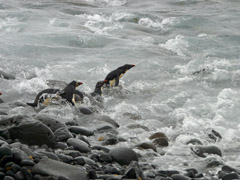
|

|
|
Penguin Finale
Edited report and pictures from Tina Glass
On 21st June, nearly three months after the first oiled Northern rockhopper penguins were brought ashore on Tristan da Cunha, the final batch of 180 birds was successfully released to the sea where they belong. This follows the release of 57 birds on 12th June.
|
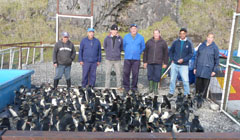
|

|
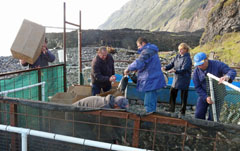
|
Gerry Repetto, Roger Glass, Eric Glass, Benny Green, Dereck Rogers
Herbert Glass and Vanessa Lavarello
gather to release the penguins
|
Gerry Repetto, Eric Glass, Dereck Rogers, John Lavarello,
Vanessa Lavarello
and Roger Glass moving the penguins
from the Release Pens |
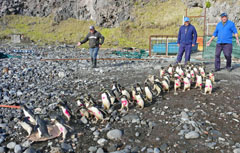
|
Above: Dereck Rogers and John Lavarello
examining one of the penguins
Left: Gerry Repetto, Roger Glass, Benny Green encouraging the penguins to go to sea
Right: Letting the last penguins go |
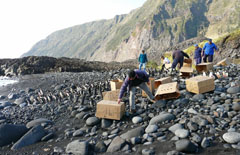
|
|
|
|
|
|
|
The final departure - until breeding birds return in August to lay eggs in September |
|
Reconciliation of penguin numbers has been tricky as some returned to sea earlier have returned. Nevertheless this immense and unique project to save the lives of as many penguins as possible has drawn to a close with a total of 381 of the original 3718 birds safely returned so sea. So the survival rate was about 10%.
When the birds were first oiled they were all at the end of their moulting cycle, so hungry and thirsty and at their weakest, and despite huge efforts by Islanders and experts from SANCCOB and the RSPB most died.
The August Tristan da Cunha Newsletter is being extended to 40 pages to include an extended feature on the MS Oliva Disaster. Make sure you join the Tristan Association to secure your copy, to be posted late July. We regret that individual copies will not be available to non-members until we satisfy and additional orders from members themselves.
Tristan Molly
The single juvenile Atlantic yellow-nosed albatross or Molly to have been found oiled, rescued, cleaned (see above) is still being cared for in the Settlement. We aim to publish news and images of 'Tristan Molly' before long, and hopefully report on a release to the wild which will need to be from height to enable the bird (probably oiled on first flight in March) to get airborne. Nevertheless this would be a major achievement and we shouldn't build up hopes too highly as has been shown by the fate of 90% of the oiled penguins. |
|

|
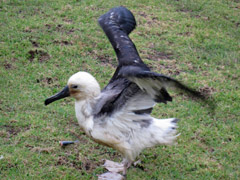
|
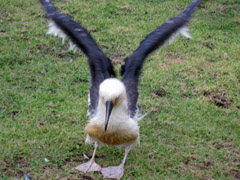
|
Molly 'Tristan' flies off
The single juvenile Atlantic yellow-nosed albatross or Molly known as 'Tristan' has been lovingly cared for
since being found oiled off Nightingale in March. Washed on 11th April (see pictures above)
the pictures above show Tristan in an open field situation taken by Tina Glass on 8th July.
A few days later, on 16th July, Tristan flew off, marking the end of the remarkable seabird rehabilitation project
which began on 23rd March a week after MS Oliva ran aground on Nightingale Island.
|
|




